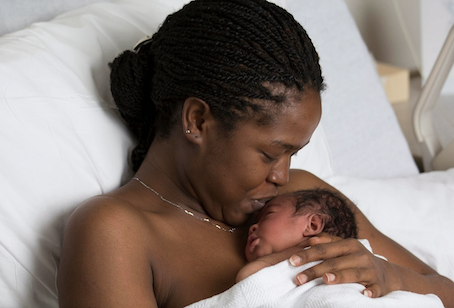
We often think of birth as the end of pregnancy, but in reality, it’s the beginning of an incredible transition. In those first moments, your baby is undergoing huge physiological changes – taking their first breath, being colonised by essential microbes, absorbing the last of their blood from the placenta, and learning to regulate their temperature. All of these processes are perfectly designed to help your baby thrive in the outside world. Here are these top 5 in detail:
1. Microbial Colonisation: Seeding the Baby’s Immune System
Let’s start with something that often surprises people – when a baby is born, their gut is not completely sterile. It is however immediately primed for colonisation – and those first few hours and days are critically important for establishing a healthy microbiome. A baby doesn’t yet have the bacteria they need to digest food properly or to protect them from infections. And here’s where nature is so clever – the process of birth is designed to seed the baby’s microbiome with exactly the bacteria they need to build a strong immune system.
During a vaginal birth, as the baby moves through the birth canal, they pick up a rich mix of bacteria from the mother’s vaginal and intestinal flora. These bacteria colonise the baby’s skin, mouth, and gut, where they begin to shape the immune system, helping the baby learn which microbes are friendly and which ones to fight off.
If a baby is born via C-section, and they don’t pass through the birth canal – or they are induced before they are ready to be born – they miss out on some of that initial cocktail of bacteria. But skin-to-skin contact and exposure to the parent’s saliva – through kissing, talking, and touching – can help to compensate for this, providing an opportunity for the baby to be colonised by beneficial bacteria in a different way.
One of the simplest ways to support this process, regardless of how a baby is born, is to delay wiping them down immediately after birth. That layer of vernix and the fluids from birth contain important microbes that are best left undisturbed for a while.
2. The Transfer of Blood Through the Cord
Now let’s talk about the umbilical cord, because this is something that is so often misunderstood in modern maternity care.
When a baby is born, the placenta is still attached to the uterine wall, and the cord continues to pulse, transferring oxygen-rich blood to the baby. This blood is full of stem cells, iron, and immune-boosting properties that help the baby transition smoothly to life outside the womb.
In many hospital settings, the cord is routinely clamped and cut almost immediately, but this interrupts the natural process of transition. The baby is still adapting to breathing air, and their body is relying on that extra boost of oxygen while their circulation adjusts. When we leave the umbilical cord alone – ideally until it has completely stopped pulsing – we allow the baby to receive up to 30% of their total blood volume, which improves long-term health outcomes and reduces the risk of symptoms like anaemia. I even read once that it takes up to six months for a baby to replenish the blood that is lost at birth when the cord is cut prematurely.
It’s also important to mention that babies don’t need to cry immediately after birth. There’s a common misconception that a baby must cry to show they are breathing, but in reality, if they’re still attached to the placenta, they’re still receiving oxygen. Giving them time to transition gently, rather than rushing the process, allows them to adjust in a way that supports their physiological needs.
3. The First Breath: How the Lungs Transition
Another huge shift that happens in the first few moments after birth is the baby’s transition to breathing air.
In the womb, a baby’s lungs are filled with fluid, and they don’t rely on them for oxygen. Instead, they receive everything they need through the placenta. But during birth, as the baby moves through the birth canal, their chest is compressed, helping to push that fluid out.
Then, once they are born, their first breaths help to inflate the lungs fully and establish independent breathing. Skin-to-skin contact plays a crucial role here – being on their mother’s chest helps regulate the baby’s breathing, ensuring that their oxygen levels stabilise.
This is why it’s so important to keep babies close and undisturbed immediately after birth. Separating them too soon can disrupt this process, making it harder for them to adapt.
4. Temperature Regulation: The Role of Skin-to-Skin
Speaking of skin-to-skin, let’s talk about temperature regulation.
Newborns are not great at keeping themselves warm. They don’t have much body fat, (particulary if they have been born before they are ready) and their ability to generate heat is limited. But the amazing thing is, a mother’s chest can act like a natural incubator.
When a baby is placed skin-to-skin on the mother’s chest, her body automatically adjusts its temperature to warm or cool the baby as needed. Research has shown that a mother’s breasts can even heat up on one side and cool down on the other – in the case of multiples – depending on what each twin needs!
This means that keeping the baby skin-to-skin isn’t just about bonding – it’s a crucial physiological function that helps the baby adapt to life outside the womb. This is why routine practices like weighing the baby or wrapping them up in blankets right away can be disruptive. The baby is best kept on their mother’s chest, skin-to-skin, until at least after the first feed.
5. Colostrum: Nature’s First Superfood
That brings us to our final one – colostrum.
There’s a common misconception that newborns need large amounts of milk straight away, but in reality, colostrum – the first milk produced by the mother – is exactly what they need.
Colostrum is thick, rich, and packed with antibodies that help to protect the baby from infections. It also has a laxative effect, helping the baby pass meconium, which in turn helps to flush out excess bilirubin and prevent jaundice.
The baby’s stomach is tiny at birth – about the size of a marble – so they don’t need large amounts of milk. Frequent feeding in the first few days helps to stimulate milk production, ensuring a smooth transition as the mother’s mature milk comes in.
As you can see, every aspect of birth is beautifully designed to support the baby’s transition to the outside world. From microbial colonisation to the transfer of blood, lung expansion, temperature regulation, and the nourishment of colostrum, everything happens in a precise and intelligent way.
The key takeaway here is that birth works best when it’s undisturbed. The more we allow these natural processes to unfold without unnecessary interference, the safer and more supported both mother and baby will be.
If you’re expecting a baby, consider discussing these topics with your birth team. Ask about optimal cord clamping, immediate skin-to-skin, and uninterrupted bonding time. These simple things can make a huge difference in your baby’s health and well-being.
If you found this information helpful, please share it with anyone who might benefit. As always, I’d love to hear your thoughts – so feel free to reach out and continue the conversation.
